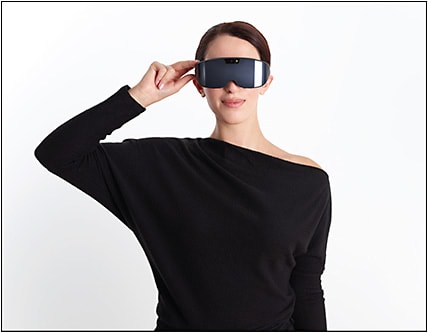The Radius XR platform offers a patient-guided exam process which makes it easier and more affordable to diagnose and follow a range of vision problems. The complete hardware and software system can also improve an eye care practice’s workflow and enable a single technician to administer several test sessions concurrently, expanding patient capacity.
The Radius XR platform consists of a head-mounted display (HMD) connected to a tablet. Some vision tests run on the tablet (eg, the Amsler grid is literally an electronic version of the paper test), while others run in the HMD. The HMD can present separate stimuli to each eye in a more controlled environment compared to what is typical for clinical settings, says Chris Bradley, PhD, director of clinical product development at Radius XR in Baltimore, Maryland. Multiple vision tests are implemented in the system, including a visual field test, visual acuity test, contrast sensitivity test, color vision, and Amsler grid test.

“The platform is designed to be streamlined and efficient,” says Roger A. Goldberg, MD, MBA, partner and retina specialist at Bay Area Retina Associates in Walnut Creek, California, an advisor on the platform’s development. The HMD’s visual field test results are quite comparable to those obtained on a Humphrey Field Analyzer (HFA), the current clinical gold standard, Dr. Goldberg says. Furthermore, unlike the HFA, the Radius XR’s visual field test doesn’t require a 5-foot by 5-foot space or a full-time tech to administer the test. Instead, the Radius XR’s test requires no space or technical support. In fact, the headset visual field exams can be given in a waiting room, lobby, or remote office.
“You can sneak it into the workflow without interrupting it,” Dr. Goldberg says. Furthermore, the device is significantly less expensive than a traditional visual field testing device. “Given all of this, a practice that frequently does visual field tests could consider having several Radius XR devices.”
“For retina practices that don’t typically have visual field testing capabilities in house, this provides an economically viable way to add this service line,” Dr. Goldberg says. This can be helpful for following patients with nonarteritic anterior ischemic optic neuropathy or papilledema, and other conditions that retina specialists often follow.
FEATURES
The Radius XR HMD also offers home monitoring options. Patient-specific test parameters can be selected (eg, which tests to perform) in the same platform, enabling greater automation of vision testing in the clinic, Dr. Bradley says.
Another benefit of the Radius XR is that testing parameters can be controlled to a greater degree in a wearable AR/VR device compared to what’s common in clinical settings, Dr. Bradley says. For example, background luminance and the subtended degrees of visual angle of a stimulus can be more precisely controlled.
The device can also serve as a patient education tool. “Physicians often need to talk about key messages repeatedly, whether it’s explaining a disease or disease treatment, or the need for ongoing treatment,” Dr. Goldberg says. “The Radius XR provides the opportunity to create a large media library of content that patients can view.” Practices can access existing content from the Radius Media Library or add their own content recorded onsite using the tablet or any device that records video. By having patients receive basic information through videos, discussions between patients and physicians can be more efficient and more time can be spent talking about core issues, Dr. Goldberg says.
Dr. Bradley adds that a practice can configure content to display automatically at an appropriate time during an exam experience, ensuring that relevant information is consistently presented. The platform also includes a business suite of management tools that streamlines patient check-in, enables staff to customize the experience for multiple patients, and makes it easier for eye-care professionals to manage business aspects critical to their practice’s ongoing success.
TESTING PROCESS
The aim of the Radius XR visual field test is to replicate the HFA in the headset. This means that it uses the same stimulus, background, and test patterns as the HFA; ie, a small spot of light 0.43° in diameter presented on a 10 cd/m2 white background using the 24-2, 10-2, and 30-2 HFA test patterns, Dr. Bradley explains.

A validation study for the Radius XR visual field test is currently under way and is scheduled to be completed in 2023. Preliminary data1 show statistical noninferiority of Radius XR visual field test results compared to the HFA.
Dr. Bradley notes that visual acuity and contrast sensitivity are tested differently on the Radius XR compared to current clinical settings. Both tests use a forced choice paradigm in which the test subject specifies the orientation of a Landolt C stimulus on each trial. This differs from testing done in a clinic with the ETDRS, Snellen, and MARS charts. However, vision psychophysics supports using a forced choice paradigm as a less-biased means of estimating detection thresholds.
The Radius XR’s Amsler grid is an electronic version of the actual Amsler grid with the same size and layout as the original. Currently, the color vision test is in development, with an anticipated release in Q1 2023.
USER EXPERIENCE AND ERGONOMICS
Clinical testing demonstrated that patients report greater comfort during visual field testing with the Radius XR compared to the HFA. “This is important because legacy visual field testing can take between four and seven minutes, and many patients find the HFA taxing,” Dr. Bradley says.
Dr. Goldberg believes the Radius XR optimizes ergonomics for eye care. “In my experience, some off-the-shelf headsets can be quite heavy and induce neck strain or a nauseous feeling,” he says.
The Radius XR is the industry’s lightest wearable device, weighing just under 6 oz, and features all-day battery life. With the look and feel of a pair of sunglasses, the platform also features a fashion-forward design. RP
REFERENCE
- Radius XR. Data on file. 2022.








